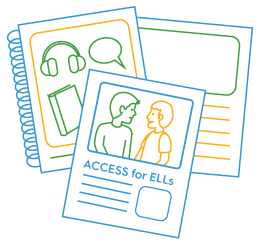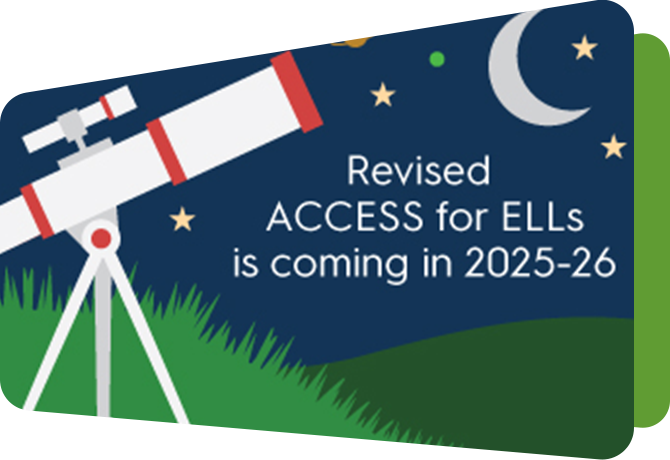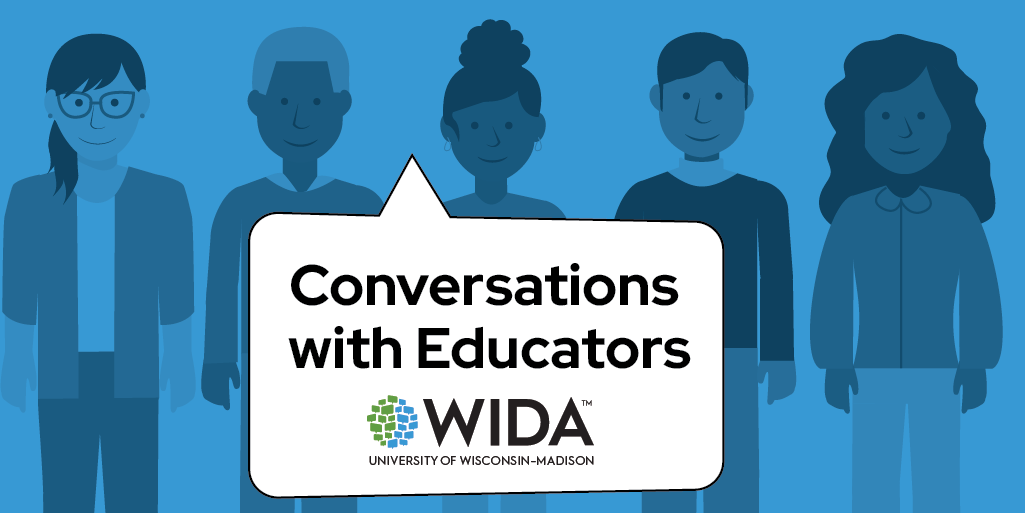Resources/Recursos
Featured Resources



All resources/Todos los recursos
Filter resources by:
Resources/Recursos
Examining Preschool-aged Dual Language Learners’ Language Use: From a Functional Approach
This study examines oral language development of 14 dual language learners ages 2.5 to 5.5 years in preschools in the Midwestern United States. They engaged in five key language uses: argue, explain, heuristic, recount, and request. Preschoolers 2.5 to 3.5 years only made simple requests or argued to meet their needs; the older cohort demonstrated a wider range of key language uses.
Resource DetailsReleased March 2016
Can Do Descriptors Name Charts, Grades K-12
This chart allows educators to track students by their level of English language proficiency.
Resource Details View Download NowReleased January 2016
Folleto de la prueba Alternate ACCESS para padres
Alternate ACCESS es una evaluación de dominio del idioma inglés para los estudiantes en los grados 1-12. La prueba se administra todos los años para ayudar a los distritos escolares a monitorear el desarrollo del idioma inglés de los estudiantes identificados como estudiantes del idioma inglés que tienen discapacidades cognitivas significativas.
Detalles del recurso Ver Descargar ahoraReleased December 2015
ENL New Arrival High School Students: Encouraging Communication in a New Language
WIDA Video Contest Winner
Mindy Lewis-Hitch develops a grade-level, standards-based unit and provides her ninth graders with clear modeling and guided practice using game-type activities for Romeo and Juliet. Mindy also demonstrates working with colleagues to help raise awareness of scaffolding lessons so all learners can be engaged.
Resource DetailsReleased June 2015
Fostering Active Comprehension: Asking and Answering Questions
WIDA Video Contest Winner
Shadia Salem encourages her first-grade students to engage in authentic inquiry before reading a text. By asking questions about the topic, students’ reading focus is linked to finding answers to their questions. Shadia’s students stay engaged by working in pairs.
Resource DetailsReleased June 2015
Academic Vocabulary Development
WIDA Video Contest Winner
Andy Mizell plans engaging instruction that scaffolds learning for the wide range of English proficiency levels in his middle school ELL class. He begins by assessing his students and collaborating with other teachers to extend his academic language instruction across subject areas.
Resource DetailsReleased June 2015
Evaluating Teacher Effectiveness Using ACCESS for ELLs
Regardless of the growth model, aggregate test-score-based models of student growth require large and longitudinally connected samples of student data. When sample sizes are small it becomes impossible to reliably estimate and disentangle district, school and teacher effects from student growth data.
Published June 2015
Author: Narek Sahakyan
Released June 2015
Students with Limited or Interrupted Formal Education (SLIFE)
This WIDA Focus Bulletin focuses on the needs of students who have limited or interrupted formal education (SLIFE). Because the vast majority of students in this group are enrolled in grades 6 through 12, we will focus on those grade levels. However, many of the tips and suggestions can be applied in lower grade levels as well. Throughout the bulletin we will explore academic and social-emotional factors that may affect this group of students, examine the benefits of building community partnerships, address how to assess student readiness levels, and offer a checklist of considerations for instructional planning.
Published May 2015
Authors: Lauren Keppler, Lucia Morales, Julia Cortada, Maria Austin
Released May 2015
Examining Relationships Between Alternate Access and State Alternate Assessments
This report examines how Alternate ACCESS for ELLs serves as a tool that identifies English proficiency attainment for English learners with significant cognitive disabilities.
Published December 2014
Author: H. Gary Cook
Released December 2014
Examining District-Level Growth Using ACCESS for ELLs
This research report provides a description of a study examining school districts in the WIDA Consortium whose English language learners (ELLs) exhibit consistently high growth on the ACCESS for ELLs (ACCESS) assessment.
Published August 2014
Authors: Narek Sahakyan, H. Gary Cook
Released August 2014
WIDA MODEL Technical Report Grades 6-8 and 9-12
This 2012 report describes the development, validity and reliability of the WIDA MODEL assessment for Grades 6-8 and 9-12.
Resource Details View Download NowReleased July 2014
WIDA Spanish Language Development Standards, 2013 Edition
The WIDA Spanish Language Development (SLD) Standards, Kindergarten – Grade 12, 2013 Edition is a resource for planning and implementing language instruction and assessment for emergent bilinguals who are learning academic content in Spanish. This publication will also offer information on where the WIDA SLD Standards fit within the larger WIDA system for instruction and assessment and how to use the SLD standards to have a broader understanding of the linguistic profile of students.
Resource Details View Download NowReleased May 2014
Collaborative Learning for English Language Learners
This research brief reports preliminary results from a study of teachers’ successful experiences engaging English learners in collaborative learning with peers.
Resource DetailsReleased May 2014
High Quality Professional Development for English Language Learners
This report describes key components of high quality professional development for educators of English language learners.
Published May 2014
Author: Daniella Molle
Released May 2014
Standards Framework and its Theoretical Foundations
This document articulates the theoretical foundations for the 2012 Amplification of the WIDA English Language Development Standards, Kindergarten-Grade 12. The 2012 Amplification and its theoretical foundations are in the process of being retired. For the most up-to-date information, please see Appendix F: Theoretical Foundations in the WIDA ELD Standards Framework, 2020 Edition.
The 2012 Amplification of the WIDA ELD Standards drew on multiple theories and approaches in an effort to describe language use in academic contexts, as this is the language students must acquire and negotiate to participate successfully in school. These multiple theories and approaches formed a theoretical foundation that supported the 2012 WIDA ELD standards framework. This document articulates that theoretical foundation.
Resource Details View Download NowReleased March 2014
Response to Instruction and Intervention for English Language Learners
Developing a Culturally and Linguistically Responsive Approach to Response to Instruction and Intervention (RtI²) for English Language Learners: Connecting to WIDA Standards, Assessments, and Other Resources
Response to Intervention or Responsiveness to Instruction (RtI) is one example of a multi-tiered system of support that helps educators identify the needs of all students as they develop more culturally and linguistically responsive educational systems. This guide includes tools and resources to help states, districts and schools address some of the unique needs of ELLs within a culturally and linguistically responsive RtI² system.
Resource Details View Download NowReleased March 2014
Implementation of the English Language Proficiency Standards Across the WIDA Consortium
This paper finds that many educators see the WIDA English language proficiency standards as a tool that can guide them in differentiating instruction and supporting language development among English language learners.
Resource DetailsReleased November 2013
Tool to Evaluate Language Complexity of Test Items
This paper focuses on the creation of an instructional hyper textbook that serves as a personal environment for learning a less-commonly-taught language, Turkish in this case. It shows how digital personal environments can advance self-regulated language learning in tandem with more formal learning strategies.
Resource DetailsReleased July 2013
Implementation of the English Language Proficiency Standards Across the WIDA Consortium
This study examined the ways in which educators across the WIDA Consortium use WIDA’s English language proficiency standards, and in particular the model performance indicators (MPIs).
Published May 2013
Author: Daniella Molle
Released May 2013
Title III National Evaluation Supplemental Report
This report addresses three primary questions:
1. How do you determine a meaningful English language performance standard?
2. How do you establish a realistic, empirically anchored time frame for attaining a given ELP performance standard?
3. How can states take into account English learners’ English language performance level when setting academic progress and proficiency expectations?
Published May 2013
Resource Details View Download NowReleased May 2013




